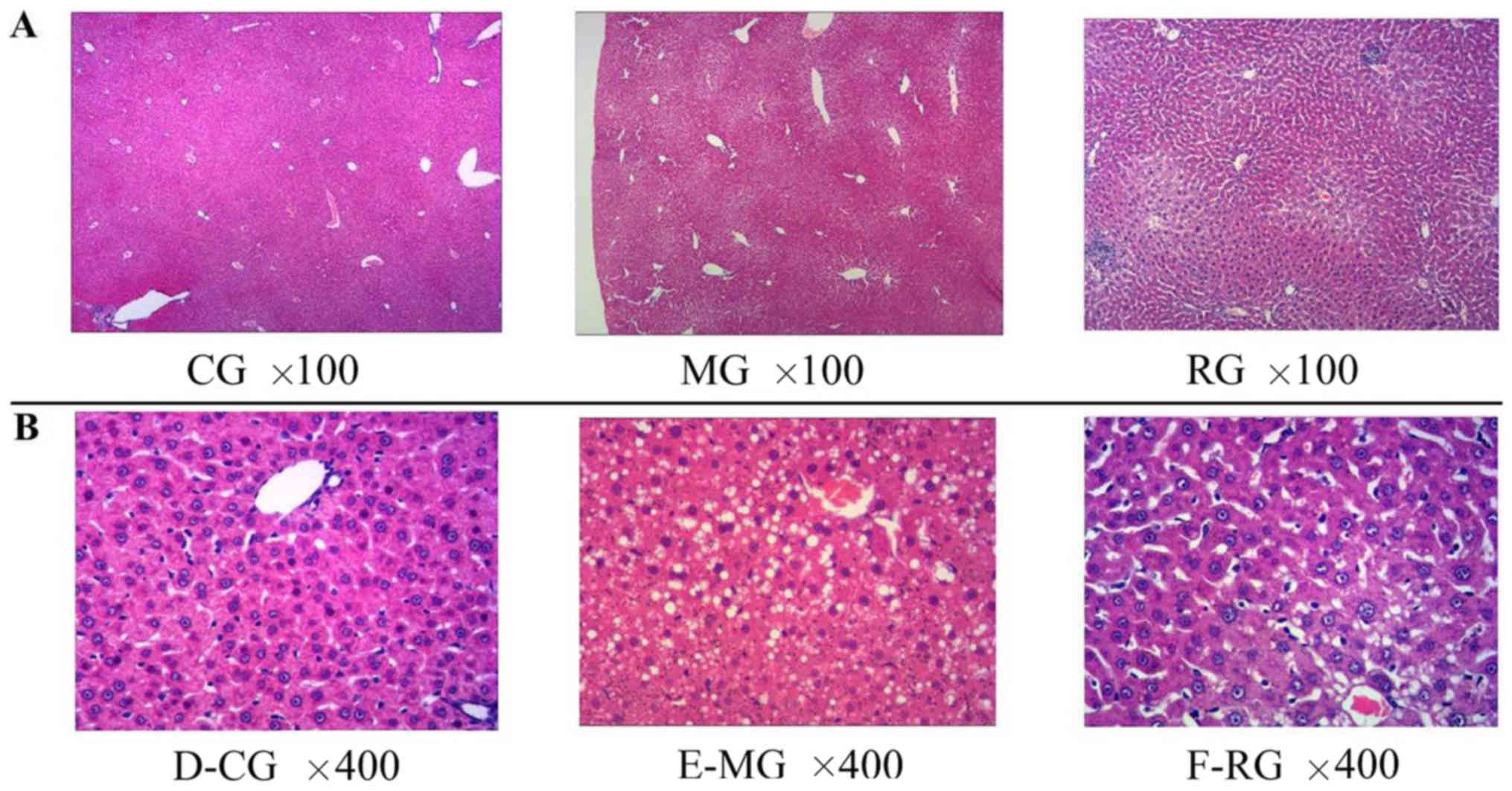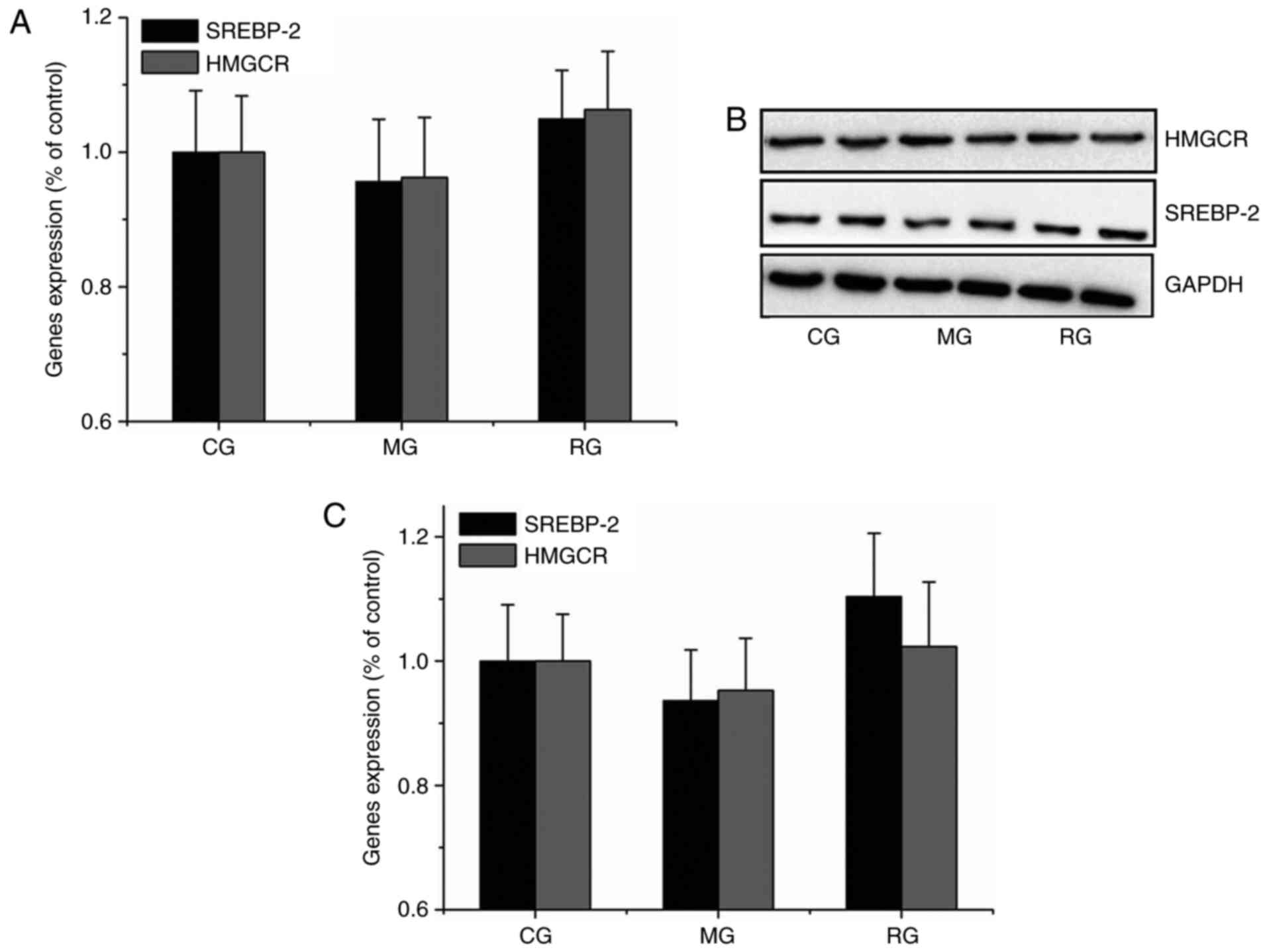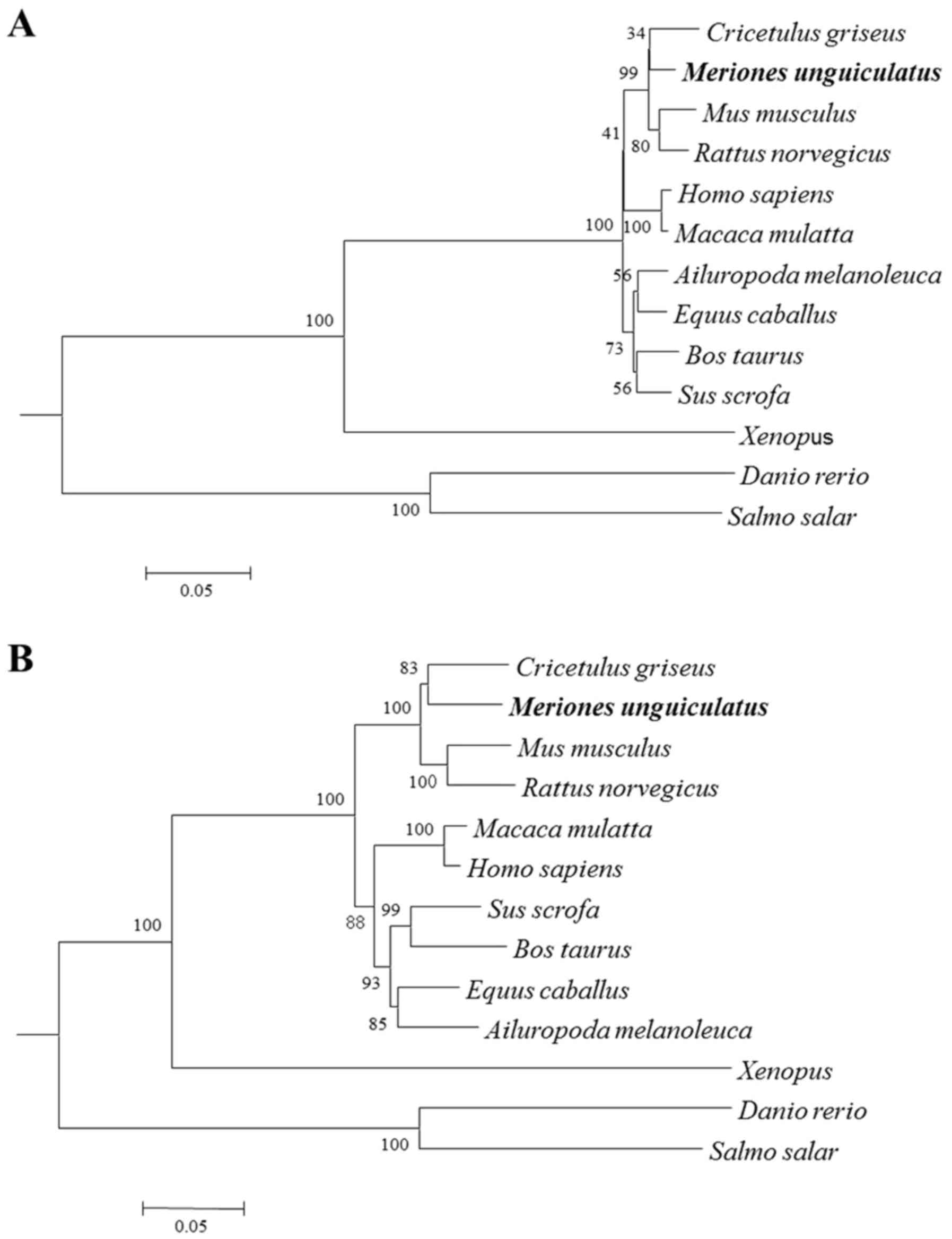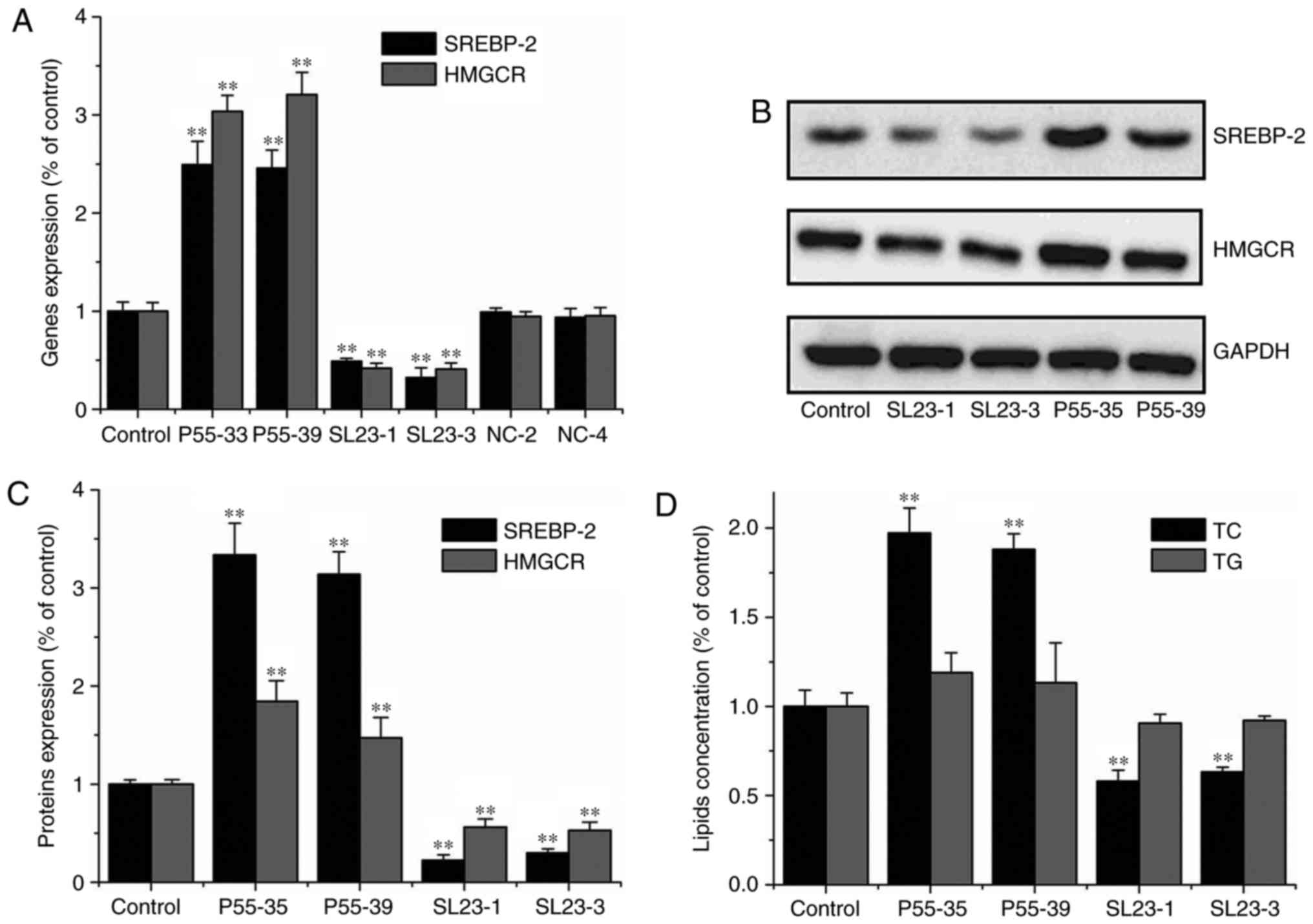|
1
|
Maxfield FR and Tabas I: Role of
cholesterol and lipid organization in disease. Nature. 438:612–621.
2005. View Article : Google Scholar : PubMed/NCBI
|
|
2
|
Liu J, Sempos CT, Donahue RP, Dorn R,
Trevisan J and Grundy SM: Nonhigh-density lipoprotein and
very-low-density lipoprotein cholesterol and their risk predictive
values in coronary heart disease. Am J Cardiol. 98:1363–1368. 2006.
View Article : Google Scholar : PubMed/NCBI
|
|
3
|
Sato R, Yang J, Wang X, Evans MJ, Ho YK,
Goldstein JL and Brown MS: Assignment of the membrane attachment,
DNA binding and transcriptional activation domains of sterol
regulatory element-binding protein-1 (SREBP-1). J Biol Chem.
269:17267–17273. 1994.PubMed/NCBI
|
|
4
|
Yang M, Liu W, Pellicane C, Sahyoun C,
Joseph BK, Gallo-Ebert C, Donigan M, Pandya D, Giordano C, Bata A
and Nickels JT Jr: Identification of miR-185 as a regulator of de
novo cholesterol biosynthesis and low density lipoprotein uptake. J
Lipid Res. 55:226–238. 2014. View Article : Google Scholar : PubMed/NCBI
|
|
5
|
Brown MS and Goldstein JL: The SREBP
pathway: Regulation of cholesterol metabolism by proteolysis of a
membrane-bound transcription factor. Cell. 89:331–340. 1997.
View Article : Google Scholar : PubMed/NCBI
|
|
6
|
Zhao GJ, Tang SL, Lv YC, Ouyang XP, He PP,
Yao F, Tang YY, Zhang M, Tang YL, Tang DP, et al: NF-Κβ suppresses
the expression of ATP-bingding cassette transporter A1/G1 by
regulating SREBP-2 and miR-33a in mice. Int J Cardiol. 171:e93–e95.
2014. View Article : Google Scholar : PubMed/NCBI
|
|
7
|
van der Wulp MY, Verkade HJ and Groen AK:
Regulation of cholesterol homeostasis. Mol Cell Endocrinol.
368:1–16. 2013. View Article : Google Scholar : PubMed/NCBI
|
|
8
|
Hegsted DM and Gallagher A: Dietary fat
and cholesterol and serum cholesterol in the gerbil. J Lipid Res.
8:210–214. 1967.PubMed/NCBI
|
|
9
|
Forsythe WA III: Comparison of dietary
casein or soy protein effects on plasma lipids and hormone
concentrations in the gerbil (Meriones unguiculatus). J Nutr.
116:1165–1171. 1986.PubMed/NCBI
|
|
10
|
Li CL, Guo HG, Shi QJ, Lou Q and Sa XY:
Establishment of a Mongolian gerbil model of hypercholesterolemia
and the effect of simvastatin. Chin J Comp Med. 20:47–52. 2010.
|
|
11
|
Choudhury RP, Carrelli AL, Stern JD,
Chereshnev I, Soccio R, Elmalem VI, Fallon JT, Fisher EA and Reis
ED: Effects of simvastatin on plasma lipoproteins and response to
arterial injury in wild-type and apolipoprotein-E-deficient mice. J
Vasc Res. 41:75–83. 2004. View Article : Google Scholar : PubMed/NCBI
|
|
12
|
Ying HZ, Liu YH, Yu B, Wang ZY, Zang JN
and Yu CH: Dietary quercetin ameliorates nonalcoholic
steatohepatitis induced by a high-fat diet in gerbils. Food Chem
Toxicol. 52:53–60. 2013. View Article : Google Scholar : PubMed/NCBI
|
|
13
|
Jia YJ, Xu RX, Sun J, Tang Y and Li JJ:
Enhanced circulating PCSK9 concentration by berberine through
SREBP-2 pathway in high fat diet-fed rats. J Transl Med.
12:1032014. View Article : Google Scholar : PubMed/NCBI
|
|
14
|
Bonkovsky HL, Jawaid Q, Tortorelli K,
LeClair P, Cobb J, Lambrecht RW and Banner BF: Non-alcoholic
steatohepatitis and iron: Increased prevalence of mutations of the
HFE gene in non-alcoholic steatohepatitis. J Hepatol. 31:421–429.
1999. View Article : Google Scholar : PubMed/NCBI
|
|
15
|
Khanna A, Morelli AE, Zhong C, Takayama T,
Lu L and Thomson AW: Effects of liver-derived dendritic cell
progenitors on Th1- and Th2-like cytokine responses in vitro and in
vivo. J Immunol. 164:1346–1354. 2000. View Article : Google Scholar : PubMed/NCBI
|
|
16
|
Chen LQ, Li CL, Guo HG, Sa XY and Chen ZW:
Establishment of a primary culture protocol of Mongolian gerbil
hepatocytes. Acta Lab Anim Sci Sin. 21:15–18. 2013.
|
|
17
|
Bartizal KF Jr, Beaver MH and Wostmann BS:
Cholesterol metabolism in gnotobiotic gerbils. Lipids. 17:791–797.
1982. View Article : Google Scholar : PubMed/NCBI
|
|
18
|
Dietschy JM, Turley SD and Spady DK: Role
of liver in the maintenance of cholesterol and low density
lipoprotein homeostasis in different animal species, including
humans. J Lipid Res. 34:1637–1659. 1993.PubMed/NCBI
|
|
19
|
Xie C, Turley SD and Dietschy JM:
Cholesterol accumulation in tissues of the Niemann-pick type C
mouse is determined by the rate of lipoprotein-cholesterol uptake
through the coated-pit pathway in each organ, Proc. Natl Acad Sci
USA. 96:11992–11997. 1999. View Article : Google Scholar
|
|
20
|
Mercer NJ and Holub BJ: Measurement of
hepatic sterol synthesis in the Mongolian gerbil in vivo using
[3H]water: Diurnal variation and effect of type of dietary fat. J
Lipid Res. 22:792–799. 1981.PubMed/NCBI
|
|
21
|
Murphy C, Parini P, Wang J, Björkhem I,
Eggertsen G and Gåfvels M: Cholic acid as key regulator of
cholesterol synthesis, intestinal absorption and hepatic storage in
mice. Biochim Biophys Acta. 1735:167–175. 2005. View Article : Google Scholar : PubMed/NCBI
|
|
22
|
Hosomi R, Fukunaga K, Arai H, Kanda S,
Nishiyama T and Yoshida M: Fish protein hydrolysates affect
cholesterol metabolism in rats fed non-cholesterol and
high-cholesterol diets. J Med Food. 15:299–306. 2012. View Article : Google Scholar : PubMed/NCBI
|
|
23
|
Plat J and Mensink RP: Plant stanol and
sterol esters in the control of blood cholesterol levels: Mechanism
and safety aspects. Am J Cardiol. 96:15D–22D. 2005. View Article : Google Scholar : PubMed/NCBI
|
|
24
|
Sever N, Song BL, Yabe D, Goldstein JL,
Brown MS and DeBose-Boyd RA: Insig-dependent ubiquitination and
degradation of mammalian 3-hydroxy-3-methylglutaryl-CoA reductase
stimulated by sterols and geranylgeraniol. J Biol Chem.
278:52479–52490. 2003. View Article : Google Scholar : PubMed/NCBI
|
|
25
|
Goldstein JL and Brown MS: Regulation of
the mevalonate pathway. Nature. 343:425–430. 1990. View Article : Google Scholar : PubMed/NCBI
|
|
26
|
Miao J, Haas JT, Manthena P, Wang Y, Zhao
E, Vaitheesvaran B, Kurland IJ and Biddinger SB: Hepatic insulin
receptor deficiency impairs the SREBP-2 response to feeding and
statins. J Lipid Res. 55:659–667. 2014. View Article : Google Scholar : PubMed/NCBI
|
|
27
|
Grenier E, Mailhot G, Dion D, Ravid Z,
Spahis S, Bendayan M and Levy E: Role of the apical and basolateral
domains of the enterocyte in the regulation of cholesterol
transport by a high glucose concentration. Biochem Cell Biol.
91:476–486. 2013. View Article : Google Scholar : PubMed/NCBI
|
|
28
|
Filipowicz W, Bhattacharyya SN and
Sonenberg N: Mechanisms of post-transcriptional regulation by
microRNAs: Are the answers in sight? Nat Rev Genet. 9:102–114.
2008. View Article : Google Scholar : PubMed/NCBI
|
|
29
|
Chevret P and Dobigny G: Systematics and
evolution of the subfamily Gerbillinae (Mammalia, Rodentia,
Muridae). Mol Phylogenet Evol. 35:674–688. 2005. View Article : Google Scholar : PubMed/NCBI
|
|
30
|
Michaux J and Catzeflis F: The bush like
radiation of muroid rodents is exemplified by the molecular
phylogeny of the LCAT nuclear gene. Mol Phylogenet Evol.
17:280–293. 2000. View Article : Google Scholar : PubMed/NCBI
|














